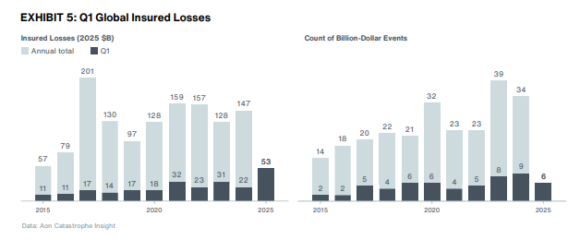Global natural catastrophes had an insured price tag of more than $53 billion during the first quarter of 2025 – claims driven by California’s wildfires of approximately $38 billion, or 71% of total insured losses across the globe, according to Aon’s Q1 Global Catastrophe Recap – April 2025.
Insured losses during the quarter ($53 billion) were significantly higher than the 21st century Q1 average of $17 billion and represented the second-highest total on record after Q1 2011.
“At least six events, all of which occurred in the United States, surpassed $1 billion in insured losses. With an additional disaster activity expected in the rest of the year, 2025 may become another costly year for insurers,” Aon said.

Q1 global economic losses were preliminarily estimated at $83 billion (Q1 2024: $54 billion), or 36% higher than the long-term 21st century Q1 average of $61 billion, Aon said, noting that economic losses (which include the insurance price tag) were driven by the California wildfires and other billion-dollar events, such as multiple severe convective storm (SCS) outbreaks across the U.S., and the earthquakes in Myanmar and China.
U.S. economic losses accounted for around $71 billion of the economic loss total, their highest since 1994 (Northridge Earthquake) and significantly above the Q1 average since 2000 ($12 billion). By contrast, Q1 economic losses in all other regions were below their long-term Q1 averages.

The figures point to an insurance protection gap of 36%, the lowest Q1 value since 1990 (47%), which Aon attributed to high insurance penetration in the U.S., where most of the losses occurred. (The insurance protection gap is the difference between total economic losses and the amount covered by insurers).
Natural disasters killed more than 6,000 people in the first quarter of 2025, compared to 1,800 in the prior year period, with the vast majority (88%) of fatalities related to the Myanmar earthquake in March. All other events during the period caused about 700 fatalities in total.
Aon’s data, inflated to 2025, show that in 2024, global natural disaster events caused $374 billion (2023: $402 billion) in economic losses in 2024, driven by hurricanes and SCS in the U.S. This was 14% above the 21st century average and the ninth consecutive year of losses exceeding $300 billion.
Aon noted that U.S. SCS insured losses have averaged $33 billion annually since 2015 – a 90% increase from the prior decade on a trended basis. SCS cost insurers $54 billion in 2024, Aon said.
Costliest Events
High Q1 insured and economic losses were driven by destructive California wildfires in January, when more than 18,000 structures were damaged or destroyed by the Palisades and Eaton Fires, with total insured losses estimated at $37.5 billion and an economic price tag of $52.5 billion. Another more than $10 billion in insured losses were generated by multiple SCS outbreaks across the United States.
Outside the U.S. region, Windstorm Éowyn (which hit the UK and Ireland on Jan. 24) was the costliest event in Q1 2025, resulting in insured losses of approximately $690 million (€620 million) and economic lossses $890 million (€800 million). Éowyn became the costliest windstorm on record in Ireland, with insurance payouts reaching $335 million (€300 million).
In addition, Cyclone Alfred, which affected Australia’s Queensland in early March, had aggregated insured losses of approximately US$750 million (A$1.2 billion), said Aon, quoting statistics from the Insurance Council of Australia (ICA).
Photograph: A firefighter battles the Palisades Fire as it burns a structure in the Pacific Palisades neighborhood of Los Angeles, Jan. 7, 2025. (AP Photo/Ethan Swope, File)
Topics Natural Disasters Carriers Profit Loss
Was this article valuable?
Here are more articles you may enjoy.



 USI Says Lockton, Former Team Leader Poached Workers, Harmed Client Relations
USI Says Lockton, Former Team Leader Poached Workers, Harmed Client Relations  Class Action Accuses Toyota of Illegally Sharing Drivers’ Data With Progressive
Class Action Accuses Toyota of Illegally Sharing Drivers’ Data With Progressive  Allstate Agent Can Be Sued Over Nonrenewal of ‘Grandfathered’ Flood Insurance Policy
Allstate Agent Can Be Sued Over Nonrenewal of ‘Grandfathered’ Flood Insurance Policy  Florida Bill Advances, Would End Board of Engineers, Other Professional Agencies
Florida Bill Advances, Would End Board of Engineers, Other Professional Agencies 

